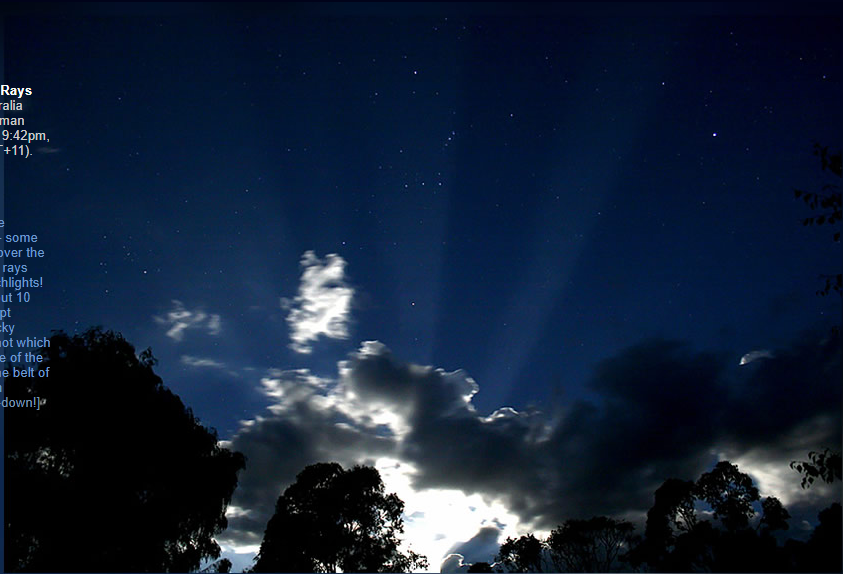Lunar Rays
Lunar Rays: A Spectacular Phenomenon in the Night Sky
When we gaze up at the night sky, we are often captivated by the beauty and mystery it holds. One fascinating atmospheric optics phenomenon that can occur during this celestial display is known as lunar rays. These ethereal beams of light, also referred to as crepuscular rays or anticrepuscular rays when observed in the presence of the Moon, create a truly mesmerizing sight that leaves us in awe. In this article, we will delve deeper into the captivating world of lunar rays and explore the science behind this spectacular phenomenon.
What are Lunar Rays?
Lunar rays are luminous beams of light that radiate outward from the Moon, resembling searchlights piercing through the night sky. These rays are most commonly observed when there are atmospheric conditions that allow for the scattering and redirection of sunlight by tiny particles suspended in the Earth's atmosphere. The interaction between these particles and the moonlight results in the formation of visible beams that extend across the sky.
The Formation of Lunar Rays
The formation of lunar rays is intricately linked to the interplay between sunlight, the Earth's atmosphere, and the Moon. When sunlight passes through the Earth's atmosphere, it undergoes a process called scattering. This scattering occurs when particles in the atmosphere, such as dust, water droplets, or ice crystals, redirect the sunlight in different directions. As a result, some of this scattered sunlight reaches the Moon's surface, creating an illumination effect.
The Role of Atmospheric Conditions
The visibility and intensity of lunar rays are greatly influenced by various atmospheric conditions. The presence of clouds can either enhance or diminish the visibility of these rays. When clouds are present, they can act as a canvas for the rays to project their brilliance upon, intensifying their effect. Conversely, if dense cloud cover obstructs the moonlight entirely, lunar rays may not be visible at all.
Types of Lunar Rays
Lunar rays can manifest in different forms, each with its unique characteristics. Some of the common types of lunar rays include:
-
Crepuscular Rays: These are the most well-known type of lunar rays, appearing as distinct beams of light that radiate outward from the Moon. They often create a fan-like pattern, resembling the spokes of a wheel.
-
Anticrepuscular Rays: When viewed opposite the direction of the setting or rising Moon, these rays appear to converge towards a point on the opposite horizon. They create an illusion of converging at the antisolar point.
-
Brocken Spectre: Occasionally, lunar rays can interact with clouds or fog, creating a fascinating phenomenon known as the Brocken spectre. This occurs when an observer's shadow is cast onto a cloud or fog bank, surrounded by a circular rainbow-like halo.
The Role of Perspective
The perception of lunar rays can vary depending on the observer's location and perspective. In the Northern Hemisphere, lunar rays appear to radiate outward from the Moon in a fan-like pattern. Conversely, in the Southern Hemisphere, these rays appear to converge towards a point on the opposite horizon. This discrepancy is due to the differing angles at which observers in each hemisphere view the Moon.
The Transient Nature of Lunar Rays
Lunar rays are a transient phenomenon, often lasting for only a short period of time. Factors such as the movement of clouds and the changing position of the Moon in the sky contribute to their ephemeral nature. It is not uncommon for lunar rays to appear and disappear within a matter of minutes, making them all the more captivating and elusive.
Capturing Lunar Rays
Photographing lunar rays can be a challenging yet rewarding endeavor. To capture these ethereal beams of light, photographers often utilize long exposure techniques to enhance their visibility. By using longer exposure times, the camera can capture the subtle nuances of the rays and create stunning images that showcase the beauty of this atmospheric optics phenomenon.
Appreciating the Beauty of Lunar Rays
Lunar rays serve as a reminder of the intricate dance between light and atmosphere that occurs in our celestial surroundings. Their enchanting presence in the night sky offers us a glimpse into the wonders of the natural world. Whether observed with the naked eye or captured through the lens of a camera, lunar rays continue to captivate and inspire, reminding us of the endless marvels that await our exploration in the realm of atmospheric optics.
In conclusion, lunar rays are a breathtaking phenomenon that adds a touch of magic to the night sky. Understanding their formation, types, and transient nature allows us to appreciate their beauty even more. So, the next time you find yourself gazing at the Moon on a clear night, keep an eye out for these celestial beams and let yourself be swept away by their mesmerizing allure.

Lunar Crepuscular Rays Bright, Victoria, Australia imaged by Rob Kaufman (atmospheric optics) 9:42pm, 10 January 2009 (UT+11). ©Rob Kaufman,
shown with permission.
"The scene was quite spectacular visually - some heavy cloud moved over the nearly-full Moon and rays spread out like searchlights! They only lasted about 10 minutes, as cloud kept moving in. I was lucky enough to get this shot which almost looks as if one of the rays is illuminating the belt of Orion (note Southern Hemisphere .upside-down!. view)."
crepuscular rays
lunar rays
Note: this article has been automatically converted from the old site and may not appear as intended. You can find the original article here.
Reference Atmospheric Optics
If you use any of the definitions, information, or data presented on Atmospheric Optics, please copy the link or reference below to properly credit us as the reference source. Thank you!
-
<a href="https://atoptics.co.uk/blog/lunar-rays-2/">Lunar Rays</a>
-
"Lunar Rays". Atmospheric Optics. Accessed on December 28, 2024. https://atoptics.co.uk/blog/lunar-rays-2/.
-
"Lunar Rays". Atmospheric Optics, https://atoptics.co.uk/blog/lunar-rays-2/. Accessed 28 December, 2024
-
Lunar Rays. Atmospheric Optics. Retrieved from https://atoptics.co.uk/blog/lunar-rays-2/.